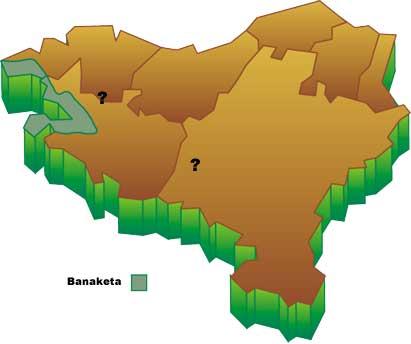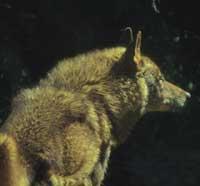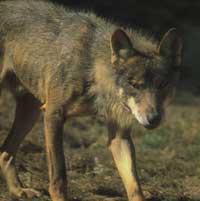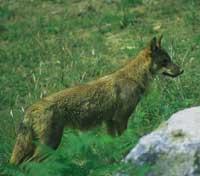February, is it the month of the wolf?
 That dark night, the pastor listened to his moving neighbors in his nightmares. However, when the flock was altered and the dog saw tails and silences, he realized that he was awake. Suddenly, when the scandal illuminated the shadow that circulated in its center, he saw those red eyes and the heart gave him that terrible blow, he had no doubt: the wolf had returned to Aralar, the heart of Euskal Herria. In history, the story, the legend, the toponyms and in our culture in general, the wolf is a leading character. The word “February” can also be considered an example of this, as for some it indicates the month of the wolf. Last year, however, May was the month in which this great predatory mammal dominated the Basques. In fact, after many years, it reappeared in our nearby territories. The wolf of the Iberian Peninsula ( Canis lupus signatus) is a strong and elegant mammal. It resembles a great German shepherd dog, but its cheek is more muscular, making it more cannibal. The neck is also good and more in winter when dressed in good hair. It has a penetrating look, golden eyes and sharp vision, a long end and a good smell, while the ears are relatively short, triangular and the ear, a good milestone. Incredible sensations for this great hunter.  In the Iberian Peninsula there are between 1,500 and 2,000 wolves (80% of the population of Western Europe) and it is estimated that in the Basque Country, northern Burgos and eastern Cantabria are between 15-25. (M.L. Elosegi) On the other hand, its legs are long and robust to support long walks. And is that the wolf is a corridor of background that can make long rapids after the hunting pieces to leave them exhausted and die later. It has a body of about 120 cm, regardless of the 40 cm corresponding to the tail. The weight is about 30 kg in females and 35 in males. Although in these latitudes there are hardly any major wolves, in northern Europe the grains of about 70 kilograms are not rare. Despite its versatility in color, it is generally a brown-greyish. A fast predator able to adapt perfectly to different situations, is found in many habitats. Formerly it appeared in lands all over Europe, but due to human pressure it was discarded towards the mountain. Nowadays there are wolves that live in plains and agricultural land, quite far from forests and mountains, but that have remained in more wild places. Try to stay away from people and it's mostly night time. Although any of the streets think that the wolf has no sheep, his diet is very varied and varied. Depending on the place of residence, but always based on meats, food can be very different. However, the typical diet of this carnivore can be, expressed in percentage, 35% for large wild animals, 25% for domestic animals, 14% for hares and rabbits, 9% for rodents, 7% for slaughter and 5% for reptiles, birds, fruits and others. In general, selecting sick, elderly, young and, in general, the most vulnerable animals is a good regulator of the health status of the wild animal population.  The wolf is a powerful and elegant carnivorous mammal. M.L. Elosegi Unfortunately, it takes the simplest path and often attacks pets, especially when there is no one who cares for them; it is not uncommon for them to kill more animals than they can eat by creating great massacres. The key to the problems and headaches generated by this animal is that, although it is not dangerous for people, yes for animals. As for the way of life, wolves gather in well-organized hierarchical groups, with close social relations between them, forming large groups of hunters. A single wolf, for example, can hardly kill a large deer, but united in group can dominate it perfectly. The coverage of females is carried out towards December-March. Between 9 and 10 weeks, in a quiet moat, the female is given 3 to 6 offspring. After 10 days, the young open their eyes and grow quickly from their mother's udder and after eating the meat their parents bring. With 2-3 months they begin to learn to hunt with their parents and in another 3-4 months they separate from them. At 2 years they reach sexual maturity and can live about 12 years. Although we have heard many times about the hybridization between wolf and dog, it must be said that it is rare. Rarely mixed and with the rage they have, the dog is one of the wolf's favorite foods.  In recent years in the Basque Country, especially in Carranza, Arcentales, Salbada, Gibijo and Valdegovía. M.L. Elosegi In Europe the wolf currently lives in Italy, the Iberian Peninsula, the Balkans and Northern and Eastern Europe. In the Iberian Peninsula there are between 1,500 and 2,000 wolves and, although in good condition in the north of the Peninsula, the populations of the south, Extremadura and Andalusia, are in serious danger of extinction. As for the situation in Euskal Herria, although the famous specimens exhibited in May 1996 abandoned these places, for 10-15 years the entry and adaptation of the wolf to the west of Araba and Bizkaia began. This expansion is understandable, on the one hand, by the regeneration of the forest with the eviction of the agricultural regions and, consequently, by the increase in the number of wild ungulates (deer, roe deer, wild boars...) and on the other, by the prohibition of poisons and traps. In the Basque Country and its surroundings (Burgos and Eastern Cantabria), it has been estimated that there are about 15-25 wolves that, according to experts, will arrive in the Pyrenean area by the west and north (France) and there will be conditioned in the coming years. So far there have been beatings against the specimens that have entered our territory, with 20 wolves killed between 1987 and 1994. But... will it be so in the future? In Euskal Herria there is no place for this XXI animal. before the century? In Aralar and, in general, in populated territories such as Gipuzkoa and Bizkaia, the truth is that it is almost impossible to reconcile the wolf with grazing, but... Is it possible that these animals live in the wildest areas of our village? We hope so. However, in the next issue we will try to delve into this controversial issue.
|





